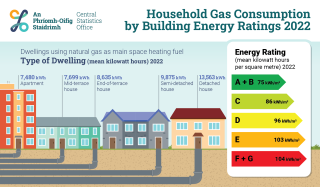Household Gas Consumption by Building Energy Ratings 2022

Investment in renewable energy and retrofitting on the scale required to meet our national climate ambition and maintain energy security requires large scale investment in infrastructure. The issues around renewable energy subsidies and energy poverty must be addressed. Too often subsidies are only taken up by those who can afford to make the necessary investments. Retrofitting is a prime example. Even with changes to these schemes introduced in 2022, those who need them most often cannot avail of them due to upfront costs, these subsidies are functioning as wealth transfers to those households on higher incomes while the costs (for example carbon taxes) are regressively socialised among all users. Incentives and tax structures must look at the short and long-term costs of different population segments; eliminating energy poverty and protecting people from energy poverty should be a key pillar of any Just Transition platform.
This recent CSO publication, 'Household Gas Consumption by Building Energy Ratings 2022' highlights the urgent need for action on retrofitting if we are to both meet our climate action goals and reduce household costs.
Key Findings
A and B rated dwellings consumed 15 per cent less gas in 2022, with similar reductions among dwellings with C ratings (15 per cent) and D ratings (15 per cent). F and G rated dwellings used 39 per cent more gas per square metre than A and B rated dwellings in 2022
More energy efficient dwellings had more floor area for each type of dwelling. A and B rated detached houses had a mean floor area of 193m2, compared with a mean floor area of 125m2 among F and G rated detached houses.
The biggest differences in consumption were seen between types of dwelling. Detached houses used 13,563 kWh of natural gas in 2022, 81 per cent higher than the 7,480 kWh consumed by apartments.
Newer dwellings consumed less gas than older dwellings. In 2022, dwellings built between 2005 and 2022 had a mean consumption of 80 kWh/m2, compared with 97 kWh/m2 for dwellings built between 1900 and 1966.
Energy Transformation
Energy is the third largest driver of emissions in Ireland. Energy-efficient homes help reduce our carbon footprint as they require less fuel to heat. One of the most cost-effective measures to promote sustainable development is to increase building energy efficiency through retrofitting. The Sustainable Energy Authority of Ireland (SEAI) estimate that €35 billion would be needed over the coming 35 years to make Ireland’s existing housing stock ‘low-carbon’ by 2050. More than 50,000 homes will have to be retrofitted every year to meet the targets set out in the Programme for Government. Investment in renewable energy and retrofitting on the scale required to meet our national climate ambition requires large scale investment in infrastructure. In order to significantly reduce Ireland’s emissions, investment in retrofitting and the national grid should be a priority.
Policy Proposals
- Government should develop a national retrofitting strategy of sufficient scale, using the learning from the SEAI deep retrofit pilot programme, with an ambitious target to deep retrofit the entire existing housing stock in a 20 year timeframe and concurrent plans to increase capacity within the construction sector.
- An upgrade of the national grid must be a key element of infrastructure investment so that communities, cooperatives, farms and individuals can produce renewable energy and sell what they do not use back into the national grid, thus becoming self-sustaining and contributing to our national targets.
- Integrate a Building Renovation Passport Scheme[1] into the National Retrofit Plan. This plan should be fully aligned with the existing Building Energy Rating (BER) system and existing retrofitting finance and regulatory measures. This would facilitate a step-by-step approach to retrofitting which could be more financially appealingand manageable for many households.
[1] https://www.igbc.ie/wp-content/uploads/2020/09/Introducing-BRP-In-Irela…